Tea in February
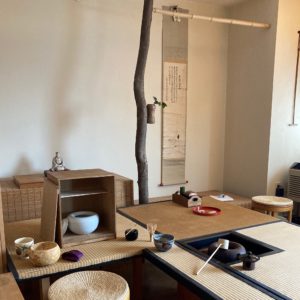
February is the coldest time of the year in Japan. Particularly, in Kyōto, the heart of Chanoyu. In traditional Japan, there was, and is, little difference between outside and inside, with only a single sheet of paper separating them. People simply put on more clothing, and warm the hands near a charcoal fire held in a hi-bachi, 火鉢, fire-bowl, or on a te-aburi, 手焙, hand-toast.

Hime Yuki-daruma, 姫雪達磨, princess snow-attain-polish, is a guise of O-ta-fuku, お多福, O-much-fortune. Otafuku has her origins in the Shintō goddess of spring, Ame-no-uzu-me no Mikoto, 天之鈿女命, Heaven-’s-comb-woman lady. She was responsible for luring Ama-terasu Ō-kami, 天照大神, Heaven-brightener Great-god, the sun goddess, out of hiding in the Ame-no-iwa-to, 天の岩戸, Heaven-’s-stone-door, after being outraged by the vile and destructive actions of her brother, Su-sa-no-mikoto, 須佐の尊, Necessary-assist-’s-lord. Uzume as Otafuku is celebrated on Setsu-bun, 節分, Season-divide, the eve of Ri-sshun, 立春, Start-spring, February 3, 2023.
The ceramic figure was conceived as an ashtray, with indentations for cigarettes at the back. However, putting a piece of burning charcoal in a bed of ash, makes a fine hand-warmer. In Japan, a typical snowman is made to look like Daruma. While sitting for nine years, Daruma lost the use of his legs, so that he is pictured without them. A hand-warmer is often presented to the guests in cold weather, and would be offered to the guests before preparing usu-cha, 薄茶, thin-tea.
Smoking articles are presented to the guest, such as the typical tabako bon, 煙草盆, smoke-plant tray. A tabako bon is usually present in the machi-ai, 待合, wait-gather, at the koshi-kake machi-ai, 腰掛待合, bottom-hang wait-gather, where guests assemble before entering the Tearoom, in the ro-ji, 露地, dew-ground, garden, and in the Tearoom for the presentation of usu-cha, 薄茶, thin-tea.
Machi-ai, 待合, wait-gather

Shiki-shi, 色紙, color-paper, pasteboard with image of a mask of O-ta-fuku, お多福, O-much-fortune, and Shintō go-hei, 御幣, hon-staff with plaited paper streamers, with calligraphy, stamped, and signed (?).
京 壬生寺 頭痛の … ふい お福さん.
Kyō Mi-bu-dera zu-tsu no … fu-i O-fuku-san.
Capital [Water’s Older Brother]-live-temple head-ache ’s … lose
The character, mi, 壬, also read Jin, used to write Mibudera, 壬生寺, is the geographical direction of north-northwest, and is a sign just to the west of the sign of Ne, 子, Rat.



When identified with the ancient capital, the gate in the actual southern quarter is identified with the sign of the Rat. The gate called Bi-fuku-mon, 美福門, Beauty-fortune-gate, is to the east of the central gate, and perhaps that is why the kanji for bi, which is also pronounced mi and fu, of fuku, were changed to mi-bu, 壬生. Perhaps the original name of the gate was written with the Kanji, 壬生, but was changed to Bi–fuku, 美福.

Tabako bon, 煙草盆, smoke-plant tray, rectangular, open wooden box with kushi-gata, 櫛形, comb-shape, sides, set with a lighter: L. 8 x 5 sun kane-jaku, hi-ire, 火入, fire-receptacle, made of a dried natural gourd, containing a piece of charcoal in a bed of ash, with an ao–dake hai-fuki, 灰吹, green-bamboo ash-blow: 4.5 sun kane-jaku, a pipe, kiseru, 煙管, smoke-tube, made of a tō, 籐, rattan, tube with brass bowl and mouthpiece: L. one kane-jaku, and paper folder, tabako ire, 煙草入, smoke-plant into, with a design of Kara-matsu, 唐松, Tang-pine, larch: 4.3 x 2 sun kujira-jaku (unfolded 9 x 5.7 sun kujira-jaku), choice of Tan-tan-sai, 淡々斎, Light-light-abstain, XIV Iemoto, Urasenke. In a Tea Ceremony setting to encourage relaxation, various smoking utensils are provided by the host, tei-shu, 亭主, house-master. The dried gourd is called a fukube, 瓢, and is wordplay on fuku as in Ota-fuku.








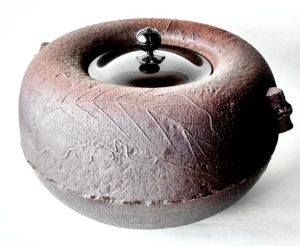
The word ubaguchi is associated with Oto-go-ze, 乙御前, Second-honored-before, who is one of Ame-no-uzume’s manifestations. The kettle’s name kashiwa-ba refers to the raised design of a large oak leaf on either side of the kama, which is to imply kashiwa-de, 柏手, oak-hands. Kashiwa-de is also the term for clapping one’s hands to get the attention of a deity at a Shintō shrine. There is wordplay on u-ba-guchi, 右左口, right-left-mouth, which refers to the right and left hands, which alludes to clapping kashiwade.
There is a famous incident in which a valiant warrior named Kashiwade no Hanoshi, 膳泣巴提使, Tray-weep-comma-carry messenger, killed a menacing tiger in a bamboo grove near a waterfall in Korea. The above-pictured kama has kan-tsuki, 鐶付, metal ring-attach, that are in the form of pieces of bamboo, and the kettle is full of water. There are often multiple and somewhat obscure meanings identified with many kama.

The famous ‘Uba-guchi gama’, 姥口釜, Hag-’s-mouth kettle, identified with the maker Ten-neko, 天猫, Heaven-cat: the vessel was once owned by O-da Nobu-naga, 織田信長, Weave-field Truth-long, and is now in the collection of the Fujitsu Bi-jitsu-kan, 藤田美術館, Wisteria-field Beauty-art-hall, Ōsaka. Note that the mouth is not so deeply sunk in the top, but the lid is flush with the top surface of the vessel. Note also the loose ring on the lid knob.

When I commissioned Andō San to make the mizusashi for a Setsubun Chakai, I wanted the vessel to evoke an image of mochi being pounded, mochi-tsuki, 餅搗き, which alludes to mochi-zuki, 望月, full-moon. And, of course suggesting O-ta-fuku, お多福, O-much-fortune.
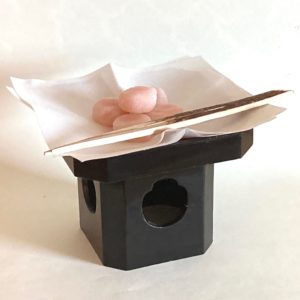

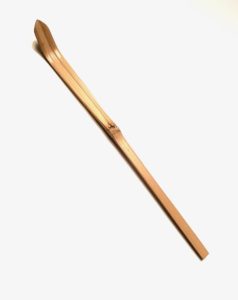



The bowl is modeled after a chawan by Hon-a-mi Kō-etsu, 本阿弥光悦, Origin-praise-increase Light-rapture, which was one of several Tea bowls without the customary ring foot. The form of the Otogoze chawan with no ring foot, kō-dai, 高台, high-support, was inspired by the Otogoze kettle of Nobunaga. Rikyū also modeled chawan on the inverted forms of various kama, 釜, kettle, with the opening mouth of the kettle as the ring foot of the Teabowl. The name ‘Otogoze’ refers to the home-ly second imperial daughter.

Futa-oki, 蓋置, lid-place, ceramic wa, 輪, ring, with an open silhouette of an oni, 鬼, demon, and a raised ‘mask’ of Otafuku, お多福, O-much-fortune, with brown glaze, by Palmer and Steven Murphy: H. 1.9 sun kane-jaku.
The lidrest illustrates the familiar phrase at Setsu-bun, 節分, Season-divide, “Oni wa soto fuku wa uchi”, 鬼は外福は内, demon is out fortune is in.
Hi-ga-shi, 干菓子, dry-sweet-of; molded sugar raku–gan, 落雁, alight-goose, O-ta-fuku men, お多福面, O-much-fortune mask, and rectangular, so-ba-ita, 蕎麦板, buckwheat-barley-board, by O-wari-ya, 尾張屋, Tail-long-house, Kyōto.





Cha-wan, 茶碗, tea-bowl, cream-colored ceramic han-zutsu, 半筒, half-cylinder, with design of a masu, 升, box measure in gold, green and gold glaze sasa, 笹, bamboo grass, leaves, and mask of O-ta-fuku, お多福, O-much-fortune (not shown), signature stamp illegible: H. 3.3 sun kane-jaku. Right: enlarged image of the masu design with Kanji gyoku-kō, 玉合, jewel-gather.
The masu measuring box is made in many sizes of specific volume capacities. Basic masu are for measuring sake, rice, beans, etc. The box is easily used to measure fractions of the full amount. There is one standard size masu which contains 6 ‘cups’, roku-gō-masu, 六合升, six-gather-measuring box. Ichi–gō, 一合, one-gather, equals 180.39 milliliters. The 6 gō masu can be used to measure one-half masu or 3 gō, and 1 gō, by holding the masu in particular ways. When a masu is depicted, the image often is shown as a hexagon, ro-kkaku, 六角, six-corner, that indicates that it holds 6 gō. The number 6, roku, 六, is symbolic of Infinity in Time, with implications of the hexagonal pattern shell of the turtle and tortoise that are believed to live 10 thousand years.
The word masu also can be written with the Kanji, 増, which means increase, add, augment, etc, and masu-masu, 益々, increasingly, more and more, etc. There is an expression, masu-masu han-jō, 益々繁盛, increase-increase luxuriant-prosper, increase prosperity.

Left: kan-nabe, 燗鍋, warm sake-pot, sake pitcher, tetsu, 鉄, iron, settled sphere with sunken mouth, long, open V-spout, raised design of the crest, go-san no kiri, 五三の桐, five-three ’s paulownia, arched bridge steel handle with scallop ‘snowflake’ edge black-lacquered wooden lid. Right: kan-nabe, 燗鍋, warm sake-pot, sake pitcher, tetsu, 鉄, iron, settled sphere with barely sunken mouth, long, open V-spout, and a raised design of a tatsu, 龍, dragon. The kannabe on the right has a mouth that is more like the mouth of Nobunaga’s Otogoze kama.

Sake may be served whenever one wishes, and in a Cha-ji, 茶事, Tea-matter, additional sake may be offered separately with an azuke dokkuri, 預け徳利, leave virtue-advantage, that is left with the guests to serve themselves. The kannabe requires a server, which is the higher position, whereas, with a sake bottle, one can serve oneself. The sake cups may be a variety of forms and materials and sizes.

Sake is sold in containers that are also publicly available in street vending machines. Sake is so enjoyed, that much effort and money are incidental to acquiring fine works of art from which to drink sake. Extravagance can know no bounds. When the Japanese government lifted restrictions on making sake, hundreds of brewers came out of the shadows with traditional and new recipes. It should be understood that sake is NOT ‘rice wine’, but a kind of flat beer, as sake is brewed, and grape wine is definitely not. In a Chaji, sake is heated, kansuke, 燗, warming sake, and never ever heated to a boil, warmed. Sake is served in small amounts so that that it is drunk in one to three sips, and should not put down with sake remaining in the cup.
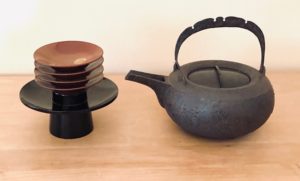
For more on Setsubun and Otafuku, see also: Setsubun and Otafuku (article), Setsubun and Risshun (article), Setsubun and Otafuku (picture gallery), Setsubun Lecture (video), Setsubun Tea Gathering (video).

